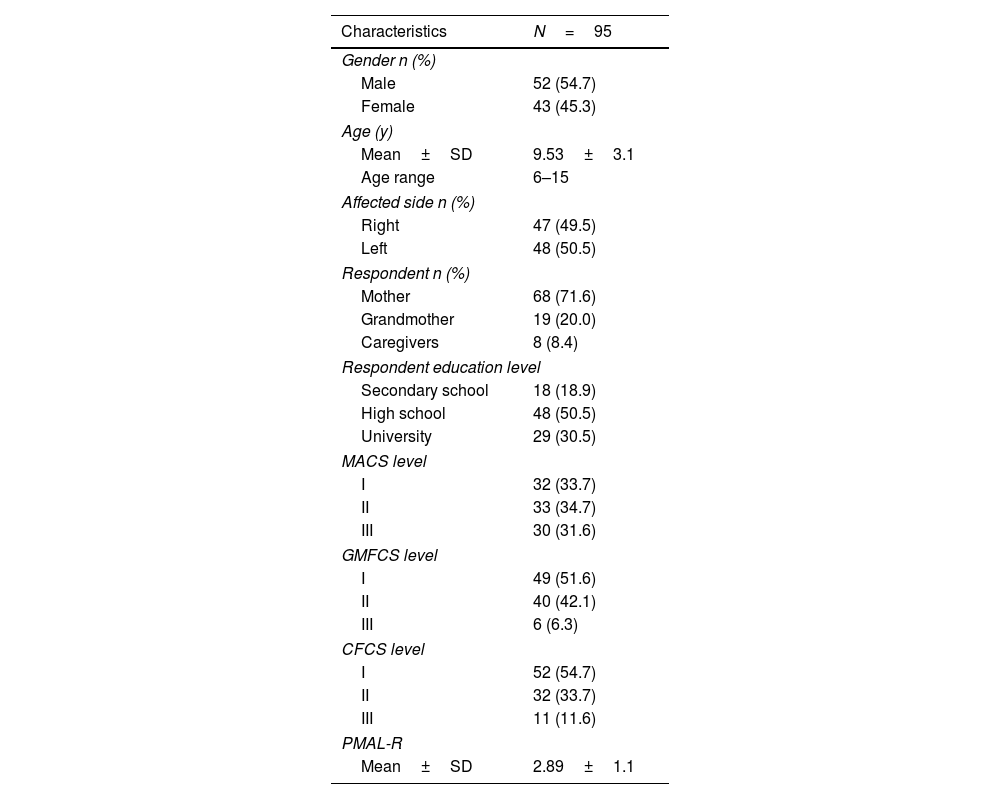To investigate relationships between amount of use of the more affected upper extremity and functional motor and communication performance classification systems.
Material and methodsThe study comprised 95 children with congenital hemiplegic cerebral palsy (CP) aged 6–15 years (52 males, 43 females; mean age 9.53, SD 3.1) and their parents/caregivers. The amount of use of the more affected upper extremity was assessed using Pediatric Motor Activity Log-Revised-How Often subscale (PMAL-R HO). Functional levels of the enrolled children were defined by the parents/caregivers using Manual Ability Classification System (MACS), Gross Motor Function Classification System-Expanded and Revised (GMFCS-E&R), and Communication Function Classification System (CFCS).
ResultsA strong and negative correlation was found between PMAL-R HO subscale score and MACS (r=−0.819), suggesting that children with lower MACS levels are more likely to use their more affected upper extremity spontaneously. Additionally, negative and moderate associations between PMAL-R HO subscale score and GMFCS and CFCS were revealed (r1=−0.549 and r2=−0.567).
ConclusionThe amount of use of the more affected upper extremity is more sensitive to MACS than GMFCS-E&R and CFCS. Children with a given MACS level had a wide range of PMAL-R HO subscale score. In addition to MACS, a score on the PMAL-R HO subscale related to the more affected upper extremity should be included as an inclusion criterion in clinical trials to avoid misleading effects of intervention approaches aimed at improving the amount of use of the more affected upper extremity in children with congenital hemiplegic CP.
Investigar las relaciones entre la cantidad de uso de la extremidad superior más afectada y los sistemas de clasificación del rendimiento motor funcional y de la comunicación.
Material y métodosEl estudio incluyó a 95 niños con parálisis cerebral (PC) hemipléjica congénita de 6 a 15 años de edad (52 varones, 43 mujeres; edad media 9,53, DE 3,1) y a sus padres/cuidadores. La cantidad de uso de la extremidad superior más afectada se evaluó utilizando la subescala Pediatric Motor Activity Log-Revised-How Often (PMAL-R HO). Los niveles funcionales de los niños incluidos fueron definidos por los padres/cuidadores utilizando Manual Ability Classification System (MACS), Gross Motor Function Classification System-Expanded and Revised (GMFCS-E&R) y Communication Function Classification System (CFCS).
ResultadosSe encontró una correlación fuerte y negativa entre la puntuación de la subescala PMAL-R HO y MACS (r=-0,819), lo cual sugiere que los niños con menores niveles de MACS tienen mayor probabilidad de utilizar su extremidad superior más afectada de manera espontánea. Además, se revelaron asociaciones negativas y moderadas entre la puntuación de la subescala PMAL-R HO y GMFCS y CFCS (r1=-0,549 y r2=-0,567).
ConclusiónLa cantidad de uso de la extremidad superior más afectada es más sensible a MACS que a GMFCS-E&R y CFCS. Los niños con un nivel dado de MACS reflejaron un rango más amplio en la puntuación de la subescala PMAL-R HO. Además de MACS, debería incluirse una puntuación en la subescala PMAL-R HO relacionada con la extremidad superior más afectada, como criterio de inclusión en los ensayos clínicos, para evitar efectos confusos de los enfoques de intervención, de cara a mejorar la cantidad de uso de la extremidad superior más afectada en niños con PC hemipléjica congénita.
Artículo
Comprando el artículo el PDF del mismo podrá ser descargado
Precio 19,34 €
Comprar ahora












